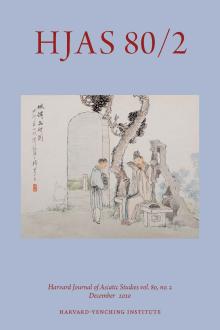December 2020
Qian Hui’an, Su Shi (Su Dongpo) Admiring Ink Stones, late nineteenth century. One leaf from an album of nine leaves; ink and light colors on paper, H. 26.4 cm x W. 32.9 cm. Harvard Art Museums/Arthur M. Sackler Museum, Bequest of Dr. Arnold Knapp, 1956.122.3. Photo: Imaging Department © President and Fellows of Harvard College.
Editorial Preface
Articles
The Death of an Artisan
Su Shi and Ink Making
Su Shi’s endorsement of an enigmatic artisan named Pan Gu as “the Ink Immortal” adumbrates the Chinese cultural valorization of ink production during and after the Song period. I parse the poet’s two-part effort to transform ink making into a legitimate field of scholarly endeavor in order to defend poets’ autonomy. In Su Shi’s view, such autonomy depends on controlling the tools that sustain literary self-expression. Resisting the passive position of a consumer, Su first identifies with and then comes to impersonate the artisan’s productive body. This pose was, however, predicated on Su’s struggle to influence the marketing of ink through verse and innovative strategies of inscription. After Su Shi, an inkstick was no longer simply a tool for the production of literature but a venue where distinctions between writing and craft could be transformed—a contested subject and substrate of literary art.
本文通過蘇軾有關墨師潘谷的詩作來探討宋代文人與墨工之間的互動關係。蘇軾通過讚揚墨工的自主性以反思文人的身份,其對玩墨與造墨的記載揭示了書寫工具對詩歌創新的影響。從蘇軾筆下之潘谷的形象演变中,我們可以看到一種中國古代特有的媒介自覺性。
The Quest for Efficiency
Knowledge Management in Medical Formularies
New textual techniques emerged in the twelfth and thirteenth centuries to facilitate the search for and use of information collected in medical formularies (fangshu). These techniques differed from those used in the production of literary and historical reference books, such as encyclopedias (leishu), because the need to find a medical treatment could be a matter of life and death. Formulary authors thus sought great efficiency in the retrieval and application of knowledge. Several material factors constrained how quickly any medicinal remedy, once found, could be prepared and offered to a patient, and formulary authors worked to limit these material constraints as part of their search for efficiency. I argue that the medically derived material constraints were the key contributors to the new textual techniques’ distinguishing features—notably, abridgement of text and ingredients—and thus explain formularies’ divergent history of knowledge-management technologies in middle-period China.
本文探討方書作者用來加速檢索和應用書中藥方的技術,及其技術在宋代的新發展。方書記載的藥方知識在應用時受到許多物質條件的限制,造成方書的檢索技術不同於類書等文史文類。探討這些新技術遂有助學界更深入地理解中古中國知識管理方法的多樣性。
Fetishism, Allegory, and Irony in Tanizaki Jun’ichirō’s Historical Novella Bushūkō hiwa
This article analyzes Tanizaki Jun’ichirō’s idiosyncratic historical novella from the 1930s, Bushūkō hiwa. Structured around the masochistic decapitation fantasy of a fictional sixteenth-century warlord, the work conspicuously incorporates fetishistic elements into the sexual history of its protagonist. By employing the logic of the fetish, which enables a subject to embrace simultaneously two contradictory beliefs, the tale affirms and deconstructs a multitude of binary oppositions, including past versus present, reading versus writing, first person versus third person, figurative versus literal, and sadist versus masochist. I also consider the narrative from a formalistic perspective and argue that the linkage of two central rhetorical devices in the narrative, allegory and irony, parallel the logic of the fetish. The novella’s allegorical framework suggests the text is a fetishistic displacement in response to the era’s imperial terror, and the novella’s ironic structure simultaneously undermines any authoritative reading.
本稿では、谷崎潤一郎『武州公秘話』に見られるフェティシズムの意義を形式主義的観点、とりわけ、寓意的アイロニーとの関わりに注視しながら考察する。二元的表象を可能にしたこのフェティシズムは、執筆当時の帝国主義的脅威に取って代わるものであった。
Rebirth as an Animal in Early Medieval Buddhism and Daoism
The doctrine of rebirth, particularly rebirth as an animal, was for early medieval Chinese one of the most difficult Buddhist doctrines to accept. This article explores the influence of pre-Buddhist Chinese ideas concerning the human-animal continuum on elaborations in tales of rebirth as an animal that appeared in apocryphal Buddhist scriptures likely written in China and in a late sixth-century Daoist scripture. I argue that this Daoist scripture borrowed Buddhist formulas explaining rebirth through the medium of a confession text authored by the Buddhist monks surrounding Liang Wudi 梁武帝 (r. 502–549), the first Chinese emperor to adopt the Buddhist religion. These texts elaborate a karmic hierarchy of beings, extending from the most loathsome of animals to the most exalted of humans. Thus these texts elucidate the social and political utility of the idea of animal rebirth for the religious writers who presented it to the ruling elite.
轉世爲動物是中國中古早期最受抵觸的佛教觀念之一。本文探討古代人與動物之間的鬆散邊界及其對佛教偽經與一部六世紀晚期道經中轉世爲動物敘事的影響,並認爲這部道經模仿了梁武帝治下僧人撰成懺悔文中的輪迴觀,最後對階層式的輪迴概念及其社會政治作用加以闡述。
